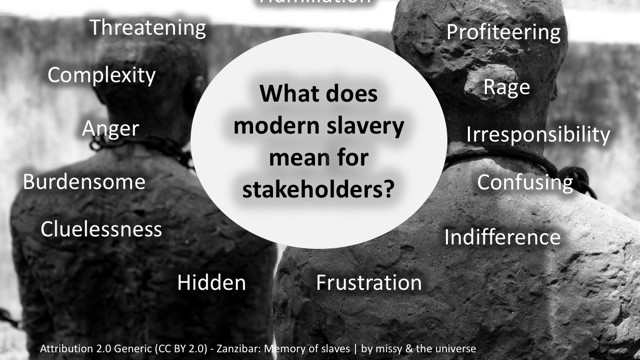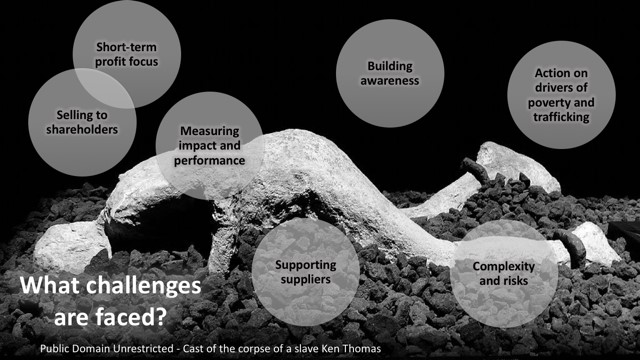
March 14, 2017, by ICCSR
Exploring Modern Slavery
The Modern Slavery Act 2015 is an Act of the Parliament of the United Kingdom. It is designed to tackle slavery in the UK by establishing a Commissioner for Anti-Slavery, and requiring businesses to publish a statement that identifies the actions taken to ensure that slavery and human trafficking are not taking place in the business or in its supply chain (See: BitC Paper).
Supply chain concerns have been on the responsible business agenda for many years. Modern Slavery and the issues of human trafficking are now reigniting critical concern for the future, as we face increasingly complex supply chains with multiple tiers of suppliers in different jurisdictions (See: Channel 4 Documentary).
Sadly, no country in the world can claim to be slavery free. Whilst the extent of issue varies between nations, there are an astounding 46 million people worldwide living under slavery. In 2016, there were 3266 recorded victims of slavery in the UK of which 30% were children. The types of crime include forced labour, sexual exploitation etc. Much of this is hidden, either by location or by the complexity of our operations. A considerable number of our products maybe the product of slavery (See: productsofslavery.org).
The UK modern slavery act requires businesses to make a statement about how companies are acting to ensure their supply chains are robust and free of human abuse. Many leading companies have strategies that assess risks of modern Slavery across their operations. For these businesses working in partnership is key to better practices in this area. Transparency is key to ensuring progress on this issue. There are estimated to be 12-17,000 companies that must comply with the Modern Slavery Act, but the Act alone is no guarantee of practice improvement. The level of compliance with the act is currently slow and patchy.
A number of local initiatives are emerging across the country to establish slaver-free communities. These projects aim to increase local resilience to slavery, raise awareness of the issue, empower civic leaders to address issues, support victims, and ensure a slavery free economy (See: Nottinghamshire Police Commissioner).
For proactive companies, the best approach maybe to act to establish a process for continual improvement, be honest and clear about what is actual done, and provide a transparent and reasonable plan for the future.
Some positive examples of corporate projects:
• John Lewis
https://www.johnlewispartnership.co.uk/content/dam/cws/images/tempfolder/csr/human-rights-june-16.pdf
• Nestle
http://www.nestle.co.uk/asset-library/documents/39506_nestle_mod-slave-act_ab_30sep.pdf
The implementation of Modern Slavery Statements is challenging, often across functional divisions from HR to logistics. Further challenges mean that smaller, second tier suppliers often face an unfair burden for the reporting of standards with larger businesses leveraging their power to force compliance and auditing costs down on to their suppliers and contracts.
Taking action
As part of a recent workshop with Business in the Community, we conducted a short exercise that looked at stakeholder perspectives on modern slavery. This was based upon a fictitious fashion retailer Wearing Well with a complex supply chain.
Participants were asked to imagine they were stakeholders of Wearing Well and to consider how Modern Slavery impacted them in this role.
• 1: Top management team of Wearing Well (CEO, COO etc.)
• 2: Employees of WW on the shop floor or in distributions centres
• 3: Local communities where Wearing Well operates
• 4: Suppliers and second tier suppliers to Wearing Well
• 5: NGOs and Media (e.g. Human Rights Watch, Transparency International etc.
• 6: National, International, and Local Government
• 7: Missing Stakeholders (e.g. Victims)
Below you can see some highlights of the discussions
What are the main learnings?
Alignment and collaboration is key to success for initiatives. In particular, establishing dialogue and partnerships with suppliers. Projects should be considered as ongoing processes for continual improvement, rather than one-off box ticking.
Establishing senior level leadership for modern slavery should be regarded as an opportunity. The cross-functional nature of the challenges needs an engaged leadership team that can bring together efforts from human capital and legal, with concerns from supplier and investor relations.
It was also felt that there was an opportunity to better align, supranational, national and local government efforts on modern slavery to ensure a more comprehensive and cohesive approach.
Making the narrative around modern slavery accessible whilst engaging with victims as human beings is essential. There needs to be balance between promoting and rewarding better behaviours as leading examples, along with greater penalties for those who ignore or worsen the problem.
No comments yet, fill out a comment to be the first




Leave a Reply